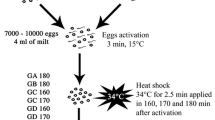Abstract
Females of Chironomus thummi thummi (stock H1) were backcrossed with hybrid males of the cross Ch. thummi thummi (H1) ♀♀ x Ch. thummi piger (E) ♂♂ in order to test which of the four piger chromosomes determine the temperature sensitive non-reciprocal gonadal dysgenesis originally observed in the thummi ♀♀ x piger ♂♂ hybrids. In the backcross rudimentary gonads as well as normal gonads were found irrespective of the chromosome constitution of the individuals. The highest frequency of abnormal gonads (63%) occurred in backcross larvae which received piger chromosomes I and III. Statistical evaluation of the data showed that piger chromosome I is able to induce 44% dysgenic gonads. The gonadal-dysgenesis inducing ability of piger chromosome III is only recognizable if also piger chromosome I is present in the genome. The piger chromosomes II and IV do not have a statistically significant influence on the frequency of abnormal gonads.
Arguments are presented for the assumption that the factors determining rudimentary development of the gonads are located distally to those pericentric chromosome regions of the piger chromosomes I and III that in polytene chromosomes show differences in the size of bands in comparison with the homologous thummi regions. The question is discussed whether the rudimentary development of the gonads is caused by gene pairs with an epistatic form of interaction or by the activity of transposable elements.
Similar content being viewed by others
References
Bregliano, J.-C. & Kidwell, M. G., 1983. Hybrid dysgenesis determinants. In: Mobile genetic elements (J. A.Shapiro ed.) pp. 363–410. Academic Press, New York.
Caspari, E. & Watson, G.S., 1959. On the evolutionary importance of cytoplasmic sterility in mosquitoes. Evolution 13: 568–570.
DeBoer, R., 1983. Nucleo-cytoplasmic interactions causing partial female sterility in the spider mite Tetranychus urticae Koch (Acarina: Tetranichidae) II. Genetica 61: 107–111.
Engels, W. R., 1979. Hybrid dysgenesis in Drosophila melanogaster: rules of inheritance of female sterility. Genet. Res. 33: 219–236.
Engels, W. R., 1983. The P family of transposable elements in Drosophila. A. Rev. Genet. 17: 315–344.
Hägele, K., 1975. Chironomus. In: Handbook of genetics (R. C.King ed.) Vol. 3 pp. 269–273. Plenum Press, New York, London.
Hägele, K., 1984. Different hybrid effects in reciprocal crosses between Chironomus thummi thummi and Ch. th. piger including spontaneous chromosome aberrations and sterility. Genetica 63: 105–111.
Hägele, K., 1986. Localization of a male sex determining chromosome region in Chironomus thummi piger. Genetica 70: 187–190.
Hägele, K., 1987. Non-reciprocal gonadal dysgenesis in Chironomus thummi hybrids: I. Temperature sensitivity of female sterility. Dev. Genet. 8: 17–26.
Hägele, K. & Speier, H., 1985. Selection of thummi specific chromosome regions in the progeny of Chironomus thummi thummi x Chironomus thummi piger hybrids after long term culturing as a consequence of gonadal sterility. Heredity 54: 159–163.
Hägele, K. & Oschmann, B., 1987. Non-reciprocal gonadal dysgenesis in hybrids of the chironomid midge Chironomus thummi III. Germ line specific abnormalities. Chromosoma 96: 50–54.
Karess, R. E. & Rubin, G. M., 1984. Analysis of P transposable elements functions in Drosophila. Cell 38: 135–146.
Keyl, H.-G., 1957. Untersuchungen am Karyotypus von Chironomus thummi. I. Karte der Speicheldrüsen-Chromosomen von Chironomus th. thummi und die cytologische Differenzierung der Subspezies Ch. th. thummi und Ch. th. piger. Chromosoma 8: 739–756.
Keyl, H.-G. & Strenzke, K., 1956. Taxonomie und Cytologie von zwei Subspecies der Art Chironomus thummi. Naturforsch. 116: 727–735.
Kidwell, M. G., 1982. Intraspecific hybrid sterility. In: The genetics and biology of Drosophila (M.Ashburner, H. L.Carson, & J. W.ThompsonJr., eds), Vol. 3c Academic Press, London and New York.
Kidwell, M. G., 1983. Hybrid dysgenesis in Drosophila melanogaster: factors affecting chromosomal contamination in the P-M system. Genetics 104: 317–341.
Laven, H., 1957. Vererbung durch Kerngene und das Problem der ausserkaryotischen Vererbung bei Culex pipiens. II. Ausserkaryotische Vererbung. Z. indukt. Abstamm.-u. Vererb.-L. 88: 478–516.
Laven, H., 1959. Speciation by cytoplasmic isolation in the Culex pipiens-complex. Cold. Spr. Harb. Symp. quant. Biol. 24: 166–173.
Neumann, D., 1971. Eine nicht-reziproke Kreuzungssterilität zwischen ökologischen Rassen der Mücke Clunio marinus. Oecologia 8: 1–20.
O'Hare, K. & Rubin, G. M., 1983. Structures of P transposable elements and sites of insertion and excision in the Drosophila melanogaster genome. Cell 34: 25–35.
Saul, G. B., 1961. An analysis of non-reciprocal cross incombatibility in Mormoniella vitripennis (Walker). Z. Vererbungsl. 92: 28–33.
Ronsseray, S. & Anxolabéhère, D., 1986. Chromosomal distribution of P and I transposable elements in a natural population of Drosophila melanogaster. Chromosoma 94: 433–440.
Author information
Authors and Affiliations
Rights and permissions
About this article
Cite this article
Hägele, K., Oschmann, B. Non-reciprocal gonadal dysgenesis in hybrids of the chironomid midge Chironomus thummi II. Gonadal-dysgenesis inducing chromosomes. Genetica 78, 185–193 (1988). https://doi.org/10.1007/BF00055637
Received:
Accepted:
Issue Date:
DOI: https://doi.org/10.1007/BF00055637




